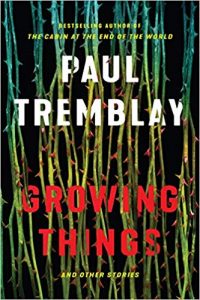Russell Letson reviews Joe Haldeman
With Earthbound, Joe Haldeman completes a sequence begun with Marsbound and Starbound. Last year, I called Starbound ‘‘a complete there-and-back-again narrative,’’ and in Earthbound the ‘‘back’’ part kicks in with, if not a vengeance, then at least a very stern warning. The warning is not the first, though explaining that requires a ‘‘Previously in the Marsbound series’’ opening montage. The first book detailed how humans met aliens on Mars who turned out to be not native Martians, but creatures created tens of thousands of years ago by the inscrutable, incredibly powerful Others for the purpose of keeping track of us if and when we achieved spaceflight. Warning Number One came when the planet-scouring bomb they devised to eliminate us dangerous pests didn’t scour the Earth as intended. Warning Two came in Starbound as a result of the first-ever interstellar expedition, sent to confront the Others in their presumed home system of Wolf 25, where new levels of inscrutability and power were revealed. Warning Three was a suggestion that we curtail all space-travel, delivered by pulverizing the moon into a spacecraft-proof rubble cloud. And when clueless Earth politicians chose to ignore that suggestion, Warning Four set the scene for this volume: the Others disabled (or, to be precise, redirected) all electrical power on the planet, effectively putting an end to technological civilization. Take that, nasty monkeys. And don’t make us have to come down there again.
The through-line character and primary narrator of the series is Carmen Dula, who starts off as a bolshy, adventurous teenager and matures into a thoughtful, resourceful, but still human-scale hero. Most of the rest of the core cast comes from the extended, multi-species family/tribe that made up the long Wolf 25 expedition: her husband Paul; her five other human companions, including a trio-marriage of military-intelligence agents; and the pseudo-Martian Snowbird. Earthbound picks up immediately at the cliff-hanger finale of Starbound, with the returned explorers wondering how Snowbird can survive on Earth without her own food and how the humans can survive at all in the short term before confronting the long-term realities of the crash of civilization.
The immediate problem comes from the persistence of the yahoo element of humanity. When the lights (and everything else, from aircraft to phones to snack machines to wristwatches) go out, the first response is gunfire, and that sets the tone for the rest of the book: with seven billion people facing starvation, the guys with the guns will call the shots. Fortunately, Carmen’s group includes four people with military training, especially the ferociously able (and genocide-haunted) ex-Mossad Namir Zahari, so they are not helpless. On the other hand, as the bumper sticker reminds us, shit happens, and Haldeman is not afraid to have it happen to his characters, especially when there is so much of it to go around – so even though they survive their first encounter with the armed and stupid, not every such meeting ends well.
This is part of the relentless procedural and operational realism that marks all of Haldeman’s work, and it means that where earlier volumes anatomized interplanetary travel and pioneering, alien encounters, starship life, or domestic polyamory, this one is almost entirely focused on getting through the early stages of total social-system breakdown. The author does give his protagonists some good cards to play: in addition to military and medical savvy, they also have a possible connection with a sustainable-technology commune (if they can get there) and eventually a channel to the Others in the form of the sporadic presence of the human-looking creature they call Spy, who was created as a kind of interface for whatever Otherly systems are dealing with humanity.
Even Spy can’t explain exactly what its operators will do or why, so the breakdown of civilization gets interrupted by a number of apparently arbitrary events, starting with the power coming back on for long enough to allow Carmen’s group to solve some immediate problems and move around the country a bit: to visit the seat of what is left of government in Washington and leave in something close to disgust; to find the commune; to leave the commune – before winding up in a situation not unlike the one at the book’s beginning. Along the way, they encounter various modes of coping, some of which result in mutual aid, while others require exchanges of gunfire and thus a steady reduction in the numbers of the star-traveler party and whatever allies they acquire. What is heartbreaking about the pockets of rationality and community spirit they find is that they are surrounded by seas of understandable desperation or outright viciousness, generally outgunned, and thus probably doomed. The resolution to this unhappy situation will remind experienced readers of certain other Haldeman novels, copies of which I will leave behind the Spoiler Curtain. You’ll recognize the pattern when you get to the end.
This tour of an unraveling society puts Earthbound squarely in the tradition of postapocalyptic novels, a tradition that seems to be having a mini-revival lately in work by John Barnes (Directive 51, Daybreak Zero) and Stephen Gould (7th Sigma). The current variations examine what happens when you pull one or two essential pieces out of the interlocking stacks that make up our civilization – plastics or petroleum or metals or electricity. One wonders, why these nightmares now? Is it just a turn of the story-generating machinery, or are these bad dreams being triggered by events in our waking lives? The accompanying, enabling motif, with deep roots in SF tradition, is that of the Others, powerful and hostile aliens whose literary ancestors include Wells’s Martians and whose modern cousins include John Varley’s Outsiders, both of whom (which?) are mysterious but not arbitrarily monstrous – they are merely Others with agendas and viewpoints that remain minimally intelligible to the monkey-folk whose lives they disrupt. As tempting as it is to see the Others as personifications of the hostile universe-at-large, that is not a symbolic gesture Haldeman seems much interested in, though there are several comparisons of humankind to lab animals who may or may not have their cages sterilized at the end of the investigation. Instead, their perhaps-capricious, perhaps-Otherly-rational treatment of our unruly species serves as an occasion to examine how much baggage we drag around with us, no matter how far into the future or out into the universe we travel.







